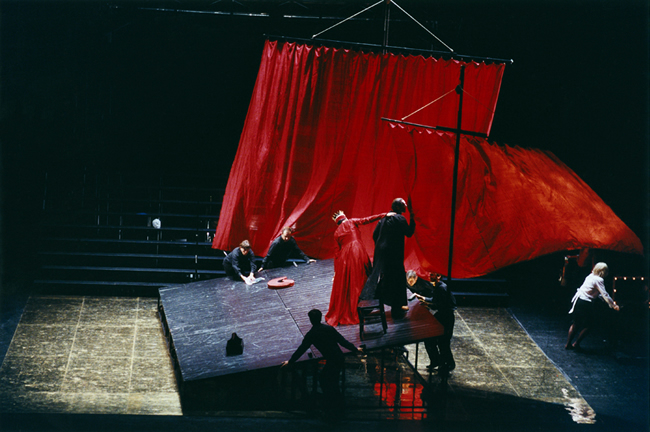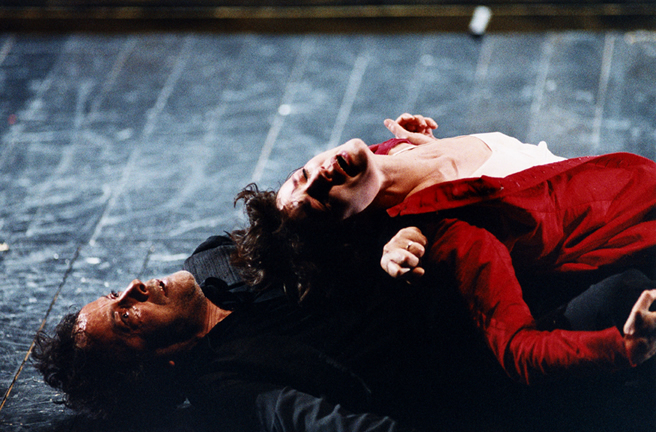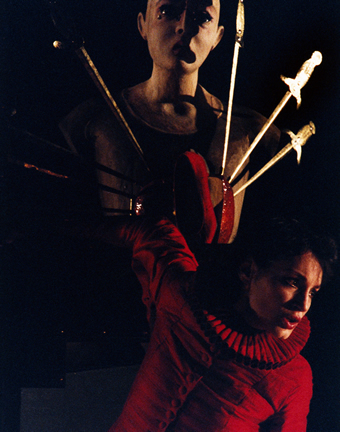If one is very demanding of the public,
why doubt that the public will be ready to give much in return?
Claudel
A woman felt that in rushing to seek her joy she was running the grave risk of rushing to her doom. So she resorts to a simple ruse, worthy of the heart of a child: taking the Virgin into her confidence she half commits the Virgin to her adventure and leaves in the arms of the Virgin's image one of her slippers. And henceforth Prouhèze, for that is her name, will be doomed to limp, and will no longer be able to take a simple step in her existence without being protected, including against herself, by this limp. Claudel wanted to let develop this story - a wild, sublime, heart-rending love story - over a number of years and across the seas so as to convey how the sacrifice of a noble soul will grow larger and larger around her, like a stone cast into the waters of creation, "its diverse, concentric rings." And so as better to resonate the harmonics of this story he chose as setting for this spiritual hunt this "golden penny" suspended in the heavens, our globe, less than a century after Christopher Columbus completed his discovery of the New World. Around the couple formed by the heroine and her beloved Rodrigue the poet's rich imagination lavishly scattered a host of secondary or immortal characters: grammarians or conquistadors, Jesuits and poor fishermen, nuns or Spanish Grandees, duped actresses, Japanese and Chinese painters, drapers and knights: dozens and dozens are those invited to join his great parade of beings.
Claudel constructed his work on the model of a autosacramental worthy of his beloved Calderon, but revised by Aeschylus and Shakespeare, a play that aims at the scale of the world and the stage. Of the world: to take its weight and density so as to extract from a few hearts, like grains in a press, their rarest, most precious sap. Of the stage: to make more vividly emerge, from a backdrop of nothingness, even the most fleeting elements of existence, or, as Olivier Py puts it, "the possibility of representing all countries and all peoples through all possible forms of the theatre." Speech, in this backdrop of night set in red and gold, can take on all tones, from the most colourful farce to the most profound lyricism. It can well up from anywhere: from a constellation, from a guardian angel in the deep recesses of a dream, or from the statue of a saint on its pedestal, as well as from the double shadow the bodies of the two embracing lovers form on the wall in the moonlight. On both sides of the Ocean, which here becomes the bitter chalice that Rodrigue and Prouhèze hold out to each other from one end of the horizon to the other, their destinies burn, spin out, twinkle like stars, the two forming the baroque epic of a salvation.
Cast
by PAUL CLAUDEL
direction by OLIVIER PY
scenography and costumes : Pierre-André Weitz
lighting : Olivier Py and Bertrand Killy
music : Stéphane Leach (except «Le Cantique de Jean Racine» by Gabriel Fauré)
costumes assistant : Nathalie Bègue
direction assistants : Olivier Balazuc and Antoine Baillet
with John Arnold, Olivier Balazuc, Jeanne Balibar, Damien Bigourdan, Nazim Boudjenah, Céline Chéene, Sissi Duparc, Michel Fau, Philippe Girard, Frédéric Giroutru, Mireille Herbstmeyer, Miloud Khétib, Stéphane Leach, Sylvie Magand, Christophe Maltot, Elisabeth Mazev, Jean-François Perrier, Olivier Py, Alexandra Scicluna, Bruno Sermonne, Pierre-André Weitz
and Sarah Abdeslam, Yasmine Bouland, Guillaume Allory, Ivan Assael, Jérôme Baubil, Benoît Becret, Claude Cuisin, Thibaut Fack, Florent Gallier, Fabienne Killy, Marc Leclercq, Philippe Meslet, Julienne Paul.
production
CDN/Orléans-Loiret-Centre
Théâtre national de Strasbourg
Théâtre de la Ville-Paris
avec le soutien de la Fondation BNP Paribas
production déléguée Odéon-Théâtre de l’Europe
Created March 12th, 2003 at CDN/Orléans-Loiret-Centre
Length :
First Part : 4 hours, 20 minutes with an interval
Second Part : 5 hours 30 minutes with an interval
In Full : 11 hours, with 3 intervals
,






